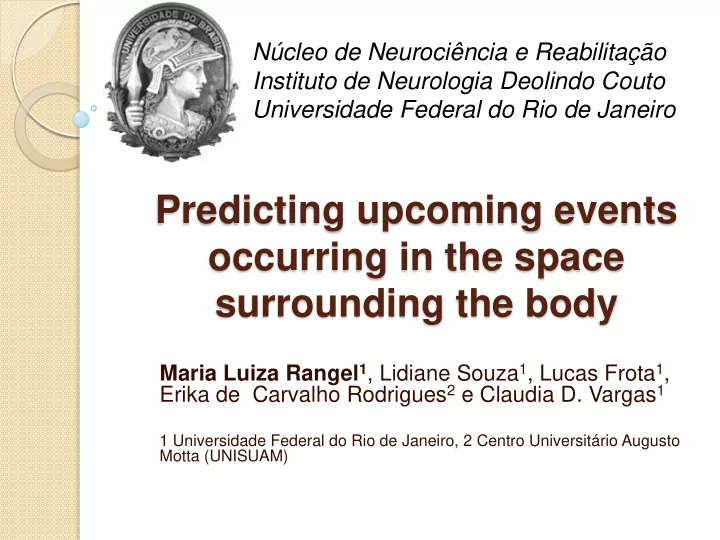

Núcleo de Neurociência e Reabilitação Instituto de Neurologia Deolindo Couto Universidade Federal do Rio de Janeiro Predicting upcoming events occurring in the space surrounding the body Maria Luiza Rangel 1 , Lidiane Souza 1 , Lucas Frota 1 , Erika de Carvalho Rodrigues 2 e Claudia D. Vargas 1 1 Universidade Federal do Rio de Janeiro, 2 Centro Universitário Augusto Motta (UNISUAM)
Predicting means choosing the next state of the upcoming movement given the knowledge of the past steps and of the inferred context. (Vargas, Rangel e Galves, 2014) forward state estimates upcoming events occurring in the space surrounding the body Proper interaction with the environment and other people Eadweard Muybridge, 1885
Hand-centered space representation Sensory guidance of movements toward objects Sensory guidance for reacting to or PREDICTION avoiding approaching objects Limbs localization in space Brozzoli et al, 2014
Movement No movement Readiness potential Movement execution 1,5s Movement observation No movement observation
Experimental Design 6 blocks (3 left / 3 right) Motor Event 60 trials 2500 ms Random presentation Sensory Event 2500 ms (...) Resting Execution - control 3000 ms 1 block – 60 trials
Methods • High density EEG (Geodesic 128 channels) • Readiness potential • Eletromyography (Biceps and FDI) EEG
Inclusion criteria Presenting RP during movement execution of the dominant hand At least 50% data epochs after bad epochs rejection No neurological and/or orthopedic health problem 18 < age < 50 Right-handed
Data pre-processing Bandpass filter 0.1 – 30 Hz Epoch segmentation (-0.1 ms – 3000 ms) Baseline: 1300 – 1500 ms Bad epoch rejection • Extreme values ±50µV, over electrodes 9, 14, 22, • Window of interest: • Observation: 1200 ms to 2500 ms • Execution : -1300 ms a 0 ms • Script emg_badtrial (Trials with muscle activity higher than 2 x sd from baseline(5s))
Participants included (green) after bad epoch rejection and inclusion criteria assesment Mantained epochs per conditon Subject RP (negative slope) Motor Sensory Hand Right hand event event at rest execution (EARLY – 0,31; LATE -2,33) S02 38 44 58 41 (EARLY -7,03; LATE 2,09) S03 19 17 40 22 S04 20 15 40 21 EARLY 0,67; LATE -7, 72) S05 51 46 47 59 EARLY -3,18; LATE -0,97) S06 31 31 31 55 Left-handed S07 42 48 45 34 EARLY 3,07; LATE -1,01 S08 42 36 47 25 EARLY -4,30; LATE -1,97 S09 22 25 16 13 EARLY 0,55; LATE -12,15 S10 24 25 18 27 EARLY -4,21; LATE -3,11 S11 48 49 48 37 EARLY 0, 92; LATE 0,24) S12 20 15 17 30 EARLY -4,14; LATE -10,35 S13 41 39 33 32 EARLY -1,36; LATE -0,78) S14 30 42 34 41 EARLY -3,52; LATE -5,77 S15 51 53 52 36
Negative Slope Fc5 Fc6 C3 C4 C5 C6 Cp3 Cp4 Cp5 Cp6 Movement onset
Results – Negative Slope (right hand observation) – Both Hemispheres Repeated Measures ANOVA (Within factors: Hemisphere: contralateral x ipsilateral; Event: Motor x Sensory x Resting) Current effect (Event): F(2,14)=5,5256, p=,01703 Vertical bars denote Std. Dv. 3,0 * 2,0 1,0 Negativve Slope (microV/s) 0,0 motor event -1,0 sensory event hand at rest -2,0 -3,0 -4,0 -5,0 * Post Hoc Newmann Keuls p<0,05
Results – Negative Slope (right hand observation) – Contralateral Hemisphere Repeated Measures ANOVA (within factor: Event: motor x sensory x resting) Current effect: F(2,14)=4,2607, p=,0358 Vertical bars denote SD 4,0 * 3,0 2,0 Negativve Slope (microV/s) 1,0 motor event 0,0 sensory event -1,0 hand at rest -2,0 -3,0 -4,0 -5,0 * Post Hoc Newmann Keuls p<0,05
Scalp maps RP for right hand observation Sensory-motor observation Hand at rest observation Grand average amplitude at Negative Slope time window (n8) – 128 channels
Our results show that a negative slope precedes the observation of an upcoming action (readiness potential) and the observation of the touch/contact of a moving object toward the hand. We suggest that the functional significance of RP includes a strong sensorial prediction component, not only a motor expectancy correlate. Could it reflect a predictive hand-centered representation of space?
Braquial Plexus Lesion (BPL) Mechanisms of sensorimotor prediction and plasticity Peripheral lesions lead to sensorimotor cortex reorganization (Cohen et al., 1991; PascualLeone et al., 1996; Flor et al., 1995; Ojemann & Silbergeld, 1995; Reilly & Sirigu, 2008; Vargas et al, 2009). Before After peripheral lesion Do these changes extende to non primary areas? Does it modulate prediction?
A case study Patient C.A.S., male, age 32. Upper trunk extended BPL Time since surgery – 5 months Hand motor function: preserved Elbow motor function : impaired (measured by Muscular manual test) Sensory Threshold 20 Monofilament Number 19 18 17 16 15 14 13 12 Hypoesthesia in the affected limb in 11 10 C.A.S. the area of contact during sensory 9 8 C.A.S. healthy event observation 7 6 Control 5 4 3 2 1 0 Median Radial Ulnar Brachial Plexus Nerve
Negative Slope modulation C.A.S affected limb observation 2 1 Negative Slope ( µ V/s) 0 Motor Event -1 Sensory Event -2 Hand at rest -3 -4 -5
Thanks!
Recommend
More recommend